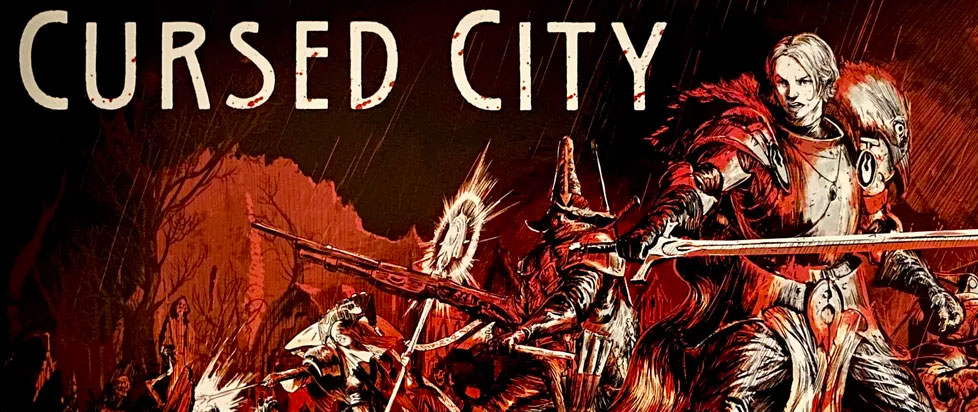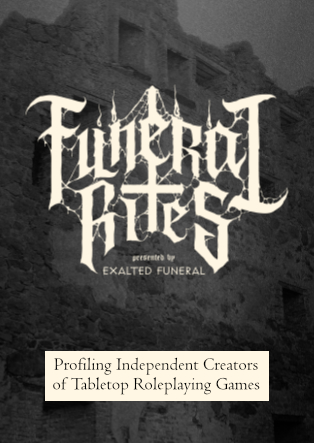
Dead Ends: Learning Something About Myself with Cursed City
I see board games in the store and they always look so cool and then I buy them and bring them home, I’m so excited to open them, and then I play them, like, twice… This column is dedicated to the love of games for those of us whose eyes may be bigger than our stomachs when it comes to playing, and the joy that we can all take from games, even if we don’t play them very often.
Not too long ago, I wrote about Warhammer Quest: Silver Tower and Shadows Over Hammerhal and, at the time, I was extremely excited because Games Workshop had just announced the next installment of their Warhammer Quest franchise, Cursed City. With gorgeous map tiles, stunning models, and a Warhammer-by-way-of-Castlevania vibe, the whole thing seemed perfect for me.
I spent months looking forward to the release of Cursed City, consuming every drop of news that leaked out from GW in the lead-up to the game’s arrival. I picked up my copy on day one, put the models together as soon as the opportunity presented itself, and played my first (solo) game as soon after that as I could.
Time has passed since then, though, and while I’ve had fun with it, Cursed City hasn’t brought the lasting happiness that I had hoped. This is less a condemnation of the game, however, than it is simply me learning something about myself, both through playing it and, more broadly, through writing this column for more than a year now.
Part of the reason I was so excited for Cursed City (besides, I mean, just look at it) was that Silver Tower had quickly become one of my favorite games in the dungeon crawl board game subgenre. And some of what makes Silver Tower so great is emphatically still there in Cursed City, but other things have changed. I’m not here to say that they are changes for the worse, so much as I am that they are changes that take the game farther from me, personally.
To understand these differences, we need to talk about the game that came between. From Silver Tower and Shadows Over Hammerhal, the Warhammer Quest franchise took a leap into the grim darkness of the far future with Blackstone Fortress, set in the world of their popular Warhammer 40K games. I have a copy of Blackstone Fortress on my shelf, along with most of its expansions, and I’ve never once regretted picking them up, even while I’ve also never actually played a game of them.
That latter is partly because Blackstone Fortress feels very intimidating in comparison to the plug-and-play nature of Silver Tower. It feels a lot more like an undertaking; a trend that has seen a rise in the dungeon crawl board game field, as games like Gloomhaven aim to make the board game experience as close to a tabletop RPG as possible. There’s nothing wrong with that, let me emphasize again, but it’s different from the very plug-and-play Silver Tower.
I dove into Cursed City in the hopes that the familiarity of its similarities to Silver Tower would help to ease some of that intimidation factor, but when you get right down to it, Cursed City has more in common with Blackstone Fortress than with its Age of Sigmar-set predecessors. In part, this is rooted in the ways the various quests are played out.
Where Silver Tower used the ol’ turning over cards to reveal the next room as you pass through doorways method, and Shadows Over Hammerhal had what essentially amounted to a dungeon master, Cursed City takes a methodology more similar to Blackstone Fortress, where a series of missions or combat encounters are handled using fixed maps, or, in one type of mission, randomly occurring maps that you must rush through like a scrolling level in a video game to keep ahead of a “suffocating gravetide.”
You level up as you go and, once you complete enough of these missions, you unlock the opportunity to go up against one of the game’s five bosses. Take out each boss in turn and you eventually work up to a conflict with the big bad, in this case Radukar the Wolf, the vampire who rules the eponymous cursed city of Ulfenkarn.
This is pretty clearly intended to increase the scope of the game. You’re looking at playing dozens of missions before you’ve completed all that even the core box has to offer. This is great in theory, especially when the box costs around $200. But when you’re only going to play a game, like, twice, it doesn’t always feel worth the bother.
Which brings me back around to what I learned about myself from all of this. Plenty of these kinds of games advertise themselves on their scope; on the “epic” quest that you’re there to undertake. But that’s apparently not what I want from them. If I want an epic quest played out across multiple sessions spanning months, I’m more likely to turn to an actual tabletop roleplaying game.
When I put a dungeon crawler on the table, what I’m looking for is something (relatively) quick that feeds that itch without the setup and investment that a TTRPG requires. I want something plug-and-play, and I want to feel like I got what the game has to offer in a single session, even while not feeling like I exhausted the game’s replay value at the same time.
Put it another way, in a market where games boast epic single campaigns that will take thirty sessions to complete, I would rather have a game with thirty different campaigns that can each be played in one sitting.
Neither approach is the wrong way to make a game, or to play them; nor is it true that I always want the same thing when I come to the table. In fact, the best thing about our current market, which is, if anything, glutted with options, is that there are plenty of things to cater to each of these extremes, and everything in-between.





